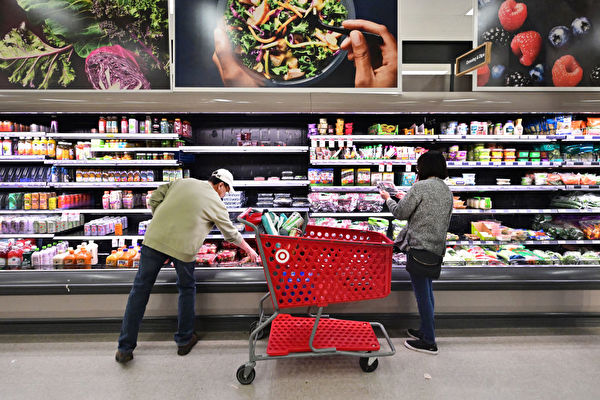The United States inflation is slowing down, aiming to achieve the Federal Reserve’s target of 2%, but this does not mean that the problem has been resolved. The impact of high prices continues to burden individuals, businesses, and puts pressure on policymakers throughout America.
The US Department of Labor’s inflation report released on October 10 showed that the Consumer Price Index (CPI) rose by 2.4% year-on-year in September, slightly lower than the 2.5% recorded in August. Another inflation indicator monitored by the Federal Reserve, the Personal Consumption Expenditures (PCE) index, indicated that the August PCE increase would reach 2.2%, very close to the Fed’s 2% target.
However, CNBC pointed out that inflation is a comprehensive effect. No single measurement standard can fully reflect the actual situation. From many indicators’ perspectives, the inflation rate still remains high, far above the level that would bring peace of mind to most Americans and some Fed officials.
The core CPI index, excluding food and energy, rose by 3.3% year-on-year in September. Although Fed officials have been more focused on overall CPI data recently, historically, they have considered core CPI data a better indicator of long-term trends. This makes measuring the inflation issue in the US more complicated.
Furthermore, while some broad inflation indicators like CPI and PCE are showing signs of decline, other indicators are proving stubborn. For instance, the “sticky price” CPI used by the Atlanta Fed, which bundles together prices that are typically resistant to decrease like rent, insurance, and medical costs, increased by 4% in September.
When it comes to inflation, two things need to be remembered: the inflation rate, which is the average rise in prices over 12 months, and the cumulative impact of inflation on the economy over the past three years.
US inflation exceeded 2% for the first time in March 2021. Since then, prices have been soaring. Measured by the CPI, overall prices have surged by 18.8% since March 2021; food inflation has skyrocketed by 22%; egg prices have soared by 87%; car insurance has jumped by nearly 47%; while gas, although currently on a downward trend, increased by 16% back then; and since the first quarter of 2021, the median house price has risen by 16%.
The soaring prices make it hard for people to believe that inflation is easing.
Overall, small companies are also feeling pessimistic. A survey conducted by the National Federation of Independent Business in September revealed that 23% of respondents still consider inflation as their main issue, making it a top concern among members.
Last Tuesday, Mary Daly, the President of the San Francisco Fed, like many of her colleagues, praised the easing inflation pressures but cautioned that the Fed has not declared victory and is not complacent with the current situation.
Speaking at New York University Stern School of Business, she told the audience, “We cannot guarantee continued progress in achieving our goals, so we must remain vigilant.”
Although complaints about rising living costs persist, people continue to spend money. According to data from the US Bureau of Economic Analysis, consumer spending in the second quarter approached $2 trillion at an annual rate. Retail sales increased by 0.4% monthly, exceeding expectations.
More and more of these expenses are being supported by various forms of borrowing. Federal Reserve figures show that household debt totaled $20.2 trillion as of the second quarter of this year, increasing by $3.25 trillion, or 19%, since inflation began soaring in the first quarter of 2021. Household debt grew by 3.2% in the second quarter of this year, marking the biggest increase since the third quarter of 2022.
So far, the increase in debt has not become a major issue, but it is becoming a significant concern. The current debt default rate stands at 2.74%, the highest level in almost 12 years.
A recent survey by the New York Fed indicated that the average probability of being unable to pay off the lowest debt in the next three months has risen from 13.6% in August to 14.2%, reaching its highest level since April 2020.
It’s not just consumers who are accessing credit. Data from Bank of America shows that the usage of small business credit cards has been steadily increasing, growing by over 20% compared to pre-pandemic levels, nearing a decade-high. The bank’s economists anticipate that with the Fed’s interest rate cuts, pressure may ease, but the extent of rate cuts might be called into question if inflation proves to be “sticky.”
In September, the Fed announced a 50 basis points rate cut, but the market response was unexpected, leading to a rise in mortgage rates. According to Freddie Mac data, since the rate cut, 30-year fixed mortgage rates have increased by about 40 basis points, further adding to the burden of homeowners.
Jamie Dimon, Chief Executive Officer of JPMorgan Chase, recently stated that the US economy still faces several critical issues.
“While inflation is slowing down and the US economy remains resilient, there are still several critical issues, including massive fiscal deficits, infrastructure needs, trade reconfigurations, and global remilitarization,” Dimon added, “While we hope for the best outcome, these events and the pervasive uncertainty explain why we must be prepared for any situation.”
Earlier this year, Dimon had sounded the alarm on the US debt situation, stating that as debt is snowballing, the US is heading toward a cliff and warning that the country’s “worst outcome” would be stagflation.
This article has been referenced from CNBC’s reports.

